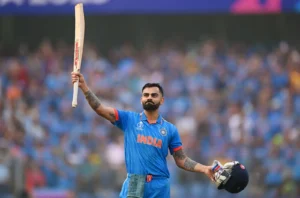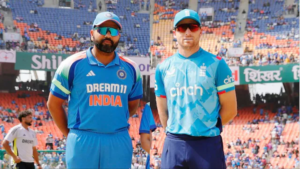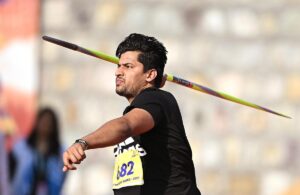Wankhede Stadium Turns 50: From Ticket Disputes to Historic Triumphs, the Legacy Lives On
 As former Indian cricketer Vinod Kambli walked into Wankhede Stadium, he found himself wondering, “If I were playing today, where would I hit a six?” Kambli, who recently returned from a hospital stay due to multiple health issues, was among the many Mumbai cricket legends present at a special ceremony honoring former captains.
As former Indian cricketer Vinod Kambli walked into Wankhede Stadium, he found himself wondering, “If I were playing today, where would I hit a six?” Kambli, who recently returned from a hospital stay due to multiple health issues, was among the many Mumbai cricket legends present at a special ceremony honoring former captains.
On January 19, 2025, Wankhede Stadium marks its 50th anniversary—a milestone celebrated through a series of events organized by the Mumbai Cricket Association (MCA). The iconic venue, which serves as the headquarters of the Board of Control for Cricket in India (BCCI) and was the site of India’s historic 2011 World Cup victory, will host week-long celebrations culminating in a grand musical night. MCA President Ajinkya Naik emphasized the importance of preserving Wankhede’s history, ensuring future generations understand its significance in Mumbai cricket.
A Stadium Born from a Ticket Dispute
Wankhede Stadium’s journey began with a dispute over ticket distribution. Before its existence, Brabourne Stadium, owned by the Cricket Club of India (CCI), hosted all international matches in Mumbai. However, a disagreement between the Bombay Cricket Association (BCA) and CCI led to the birth of a new stadium.
Barrister Sheshrao Wankhede, a former Maharashtra Assembly Speaker, was denied extra tickets for an international match by then CCI President and former cricketer Vijay Merchant. Soon after, when Brabourne Stadium refused to host an exhibition match for the Maharashtra government, Wankhede took it upon himself to build a new cricketing venue. With support from the Maharashtra government and financial backing from Tata and Garware—who later had stadium ends named after them—Wankhede Stadium was constructed on a plot previously used as a college playground.
Challenges and Architectural Feats
Building the stadium came with its challenges. The land was sandwiched between a railway track, a hockey stadium, and residential buildings, making construction a logistical puzzle. Yet, the venue took shape and became a multi-sport hub, hosting not just cricket but also hockey and football matches.
Former India women’s team captain Diana Edulji reminisced about a special moment from 1975 when she bowled to West Indies great Clive Lloyd in the nets, only to be humbled by a six when she insisted he play at full strength. Former Mumbai captain Milind Rege recalled how, during the first Ranji Trophy match at Wankhede in 1974, players had to walk a long distance from an inconveniently placed dressing room. When one of them slipped while wearing spikes, the MCA was forced to rethink the layout.
A Changing Experience for Spectators
In its early days, Wankhede lacked modern conveniences. CS Naik, the stadium’s longtime executive secretary, recalled how, before numbered seating, fans would cram onto wooden benches designed for just 25 people. Some even used the same ticket multiple times to smuggle extra spectators inside.
Over the decades, the stadium witnessed several historic cricketing moments. The 1983 World Cup-winning Indian team had their photoshoots here, the victorious 2007 T20 World Cup team was felicitated on this very ground, and in 2011, MS Dhoni’s unforgettable six sealed India’s World Cup triumph. More recently, when India won the 2024 T20 World Cup under Rohit Sharma, the team took a victory lap at Wankhede.
Tears and Tributes
Wankhede has seen its share of heartbreak, too. Naik recalled the famous 1990-91 Ranji Trophy final, where Mumbai lost to Haryana by just two runs. As Dilip Vengsarkar broke down, so did the entire stadium—one of the rare moments when Naik saw an entire crowd in tears.
For many players, Wankhede was more than just a cricket ground—it was a place where their mentors watched over them. Former cricketer Pravin Amre recalled spotting his childhood coach, Ramakant Achrekar, in the stands when he played a Test against England in the early ’90s. The stadium’s layout even influenced how players prepared for matches, as maidaan pandits in the North Stand would vocally critique every poor shot, while past cricketing greats sat in a special box above the dressing room, watching intently.
The Legacy Lives On
Vasant Mohite, a long-serving groundsman at Wankhede, fondly remembered a young Sachin Tendulkar politely asking where he should sit in the dressing room. But for Mohite, his most cherished memory was watching MS Dhoni’s iconic six in the 2011 World Cup final. “Woh six mere sir ke upar se gaya” (It flew right over my head), he recalled, describing it as the best seat in the stadium.
As Wankhede Stadium turns 50, it remains the ultimate cricketing shrine for Mumbai players and fans—a place where history has been made and will continue to be written.








